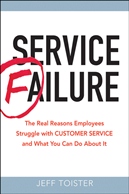3 things to know before scheduling customer service training
 Jeff Toister
Jeff Toister  Sunday, June 10, 2012 at 2:15PM |
Sunday, June 10, 2012 at 2:15PM |  When I'm asked by a prospective client to provide a quote for their employees to attend my Delivering Next Level Service workshop, it may surprise you to learn I almost always ask a few questions first. Although I'm in the business of selling customer service training classes, there are three things my clients should know before they give customer service training the green light.
When I'm asked by a prospective client to provide a quote for their employees to attend my Delivering Next Level Service workshop, it may surprise you to learn I almost always ask a few questions first. Although I'm in the business of selling customer service training classes, there are three things my clients should know before they give customer service training the green light.
#1: What's the gap?
The purpose of training is to help employees bridge the gap between current and desired performance, so you should have a clear picture of the service you want your employees to provide and the service they are actually providing now. In many cases, this starts with clearly defining what oustanding service should look like (learn more about creating your own definition) so you can understand what it will take to get there.
#2: Is the performance gap caused due to insufficient K.S.As?
Training can help develop employees' knowledge, skills, and abilities. For instance, if employees don't know how to diffuse an angry customer, training can certainly help them learn how. However, there are often other obstacles the keep people from reach their full customer service potential. For example, I recently worked with a call center client who didn't staff enough people during their times of peak demand. This caused their reps to rush through calls and become abrupt with customers. The client resolved the problem by simply adjusting their staffing levels to better match their anticipated call volume. (You can read a short case study here.)
#3: Are you missing any of the three C's?
The knowledge, skills, and abilities that employees learn in a training class can fade over time if they aren't getting enough of the three C's.
- Recency. When was the knowledge, skill, or ability last used?
- Frequency. How often is the knowledge, skill, or ability used?
- Consistency. How consistently is the knowledge, skill, or ability used?
Are you heading to a meeting to discuss customer service training? Blog posts don't always print out on a neatly formatted page, so I've created this handy checklist you can print and take with you.







